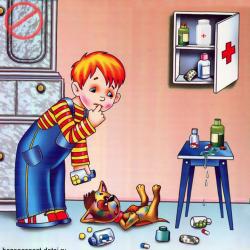Grabenko Tatyana, Zinkevich-Evstigneeva Tatyana.
Grabenko Tatyana, Zinkevich-Evstigneeva Tatyana.
Methodological workshop on sand play therapy. Grabenko T., Zinkevich-Evstigneeva T. Miracles on the sand. Methodological workshop on sand play therapy What is needed to play with sand
What do you need to play in the sand?
But, in essence, so little is needed:
Love, desire, kindness,
So that Faith in Childhood does not disappear.
The simplest drawer on the table -
Let's paint it blue
A handful of golden sand
A wondrous fairy tale will flow there.
Set of small toys
Let's take it to the game...
Like God
We will create our own World of Wonders,
Having passed the Road of Knowledge.
1. Waterproof wooden box. If you work with children in a small group (3-4 people) or individually, its size is 5Ох7Ох8 centimeters. This size of the box corresponds to the optimal field of visual perception, and this allows you to cover it entirely with your gaze. Sand therapists “lovingly” call a box with sand a “tray” - it can be equipped with handles on the sides for easy transportation. It is better if the tray is made of wood, this will make it easier to transfer the sand experience into real activities. However, it doesn’t matter if your box is made of a different material.
For classes with large groups of children, you will need a much larger box.
The inner surface of the tray (bottom and sides) is painted blue or light blue. Thus, the bottom of the tray will symbolize water, and the sides will symbolize the sky.
2. Clean, sifted sand (some even calcinate it in the oven). It should not be too large or too small.
A smaller part of the box is filled with sand. For sand games it is better if it is wet.
Thus, the sand sets the symbolic “horizon line”.
3. “Collection” of miniature figures, preferably no more than 8 centimeters high. The set of toys may include:
Human characters
Buildings: houses, schools, churches, castles
Animals: domestic, wild, prehistoric, marine, etc.
Vehicles: land, water, space, combat
Plants: trees, bushes, flowers, vegetables, etc.
Symbolic objects: sources for making wishes, treasure boxes, jewelry, etc.
Fairy-tale heroes: evil and good
Religious items and souvenirs
Living greens, etc.
Household utensils, perfume bottles, nuts, bolts, etc.
Plastic or wooden letters and numbers, various geometric shapes (circles, triangles, rectangles, pyramids, etc.)
In a word, everything that is found in the world around us can take its rightful place in your “collection”. Collecting equipment for games will not be burdensome for you, since today every child will help you with this (with figures from Kinder Surprise, parts of construction sets, etc.). If you don’t have enough figurine images for your classes, they can be sculpted from plasticine, clay, dough, or cut out of paper.
Now, you have everything to go with your child on an exciting journey through the Land of Sand Games.
The first chapter of our book is devoted to EDUCATIONAL games. They will facilitate the process of teaching a child to read, write, count and read and write.
The second chapter will take you to the land of COGNITIVE games. With their help, children will learn about how multifaceted our World is, get acquainted with the history of their city, historical heroes and events.
The third chapter describes PROJECT games. You will learn about what the unconscious “does” when a child plays with sand; discover your child’s potential; see the creative flight of his imagination; step with him into Children's World; Learn to compose and act out fairy tales with him.
Grabenko Tatyana Mikhailovna -
defectologist (teacher of the deaf, speech therapist), play therapist. Leading employee of the Institute of Fairy Tale Therapy, teacher of the Institute of Special Psychology and Pedagogy of the International University of Family and Child named after. R. Wallenberg, author of unique programs on playful fairy tale-therapeutic phonetic rhythms, laureate of the Mayor's Prize, winner of many pedagogical skills competitions.
Zinkevich-Evstigneeva Tatyana Dmitrievna- Doctor of Psychology, fairytale therapist, author of the psychological and pedagogical technology “Complex Fairytale Therapy”, rector of the Institute of Fairytale Therapy.
She received professional training from the best psychotherapists: in creative therapy techniques (Dr. R. Gardner; 1995, 1997), in the basics of behavioral therapy (Dr. H. Zeng; 1994), in dance therapy technology (Dr.
M. Berger; 1995), on the technique of sand therapy (Dr. D. Berger; 1996, 1997), on play therapy (M. Kondratova; 1997).
M Many parents often ask themselves And The question for specialists is: “When should I start teaching my child?” Some say - still in the womb mothers; others - don’t teach at all, the school will teach you; Still others will advise placing your pet in the hands of competent specialists as soon as he begins to walk and talk. Making a choice is not easy.
Let's look at the problem from the other side. Indeed, a child begins to explore the world while in the womb. Moreover, scientists have established that the basis of this process is tactile (skin) sensitivity. No wonder they say: “I feel it with my skin.” Once born, a child actively explores the world around him. Actually, this is the process of SELF-EDUCATION. Perhaps more and more often you hear from specialists the phrase: “The main thing is not to disturb the child!”
“How not to interfere? How can I stop him? - you ask yourself a question. It turns out that you can interfere if you approach the child with adult standards. How can this be avoided?
Let's watch our children. They are drawn to bright and far from safe objects; they can put both hands into a plate of semolina porridge and with great pleasure spread it all over themselves, the table and their beloved parent; they need to try everything by their teeth; but the main thing is that they are simply drawn to what is IMPOSSIBLE. Of course, all this causes a lot of trouble for adults. And we are FORCED, as caring parents and teachers, to set a series of prohibitions for the child. So, brick by brick, the “Wailing Wall” grows and strengthens, separating and distancing the worlds of the Child and the Adult.
How can we maintain the connection between our worlds: give the child the opportunity and right to develop at his own pace, to guide without limiting? Let's put these questions aside for a while and turn to the Child who lives INSIDE each of us. Surely, he wants to create something of his own;
Breaking to feel strong, but at the same time feel protected. These wishes can be realized in games with sand.
With what ecstasy children steam soups and cereals from sand and feed them everyone in a row: dolls, you, guests! However, they often repeat remarks heard from you: “To eat everything to the end!”, “I tried so hard!”, "Here a lot of vitamins!”, “A spoon for mom, a spoon for dad”, etc. It is on the sand that the first house in life is built, a tree is planted, a “family” is created. All this is the World of the Child, and in which he feels protected, where everything is close and understandable to him. And this is a reflection of our Adult Mira.
Now, probably It will be easier for you to answer the question: when and how start off child education. Perhaps when you intuitively feel ready to join the process of his self-development. We hope that our book will help you
Introduction
Didn't any of us play Easter cakes when we were kids? A bucket, molds, and a scoop are the first things you buy for your child. Children's first contacts with each other
take place in a sandbox. These are traditional sand games. We will look at the possibilities of using the sandbox from the pedagogical side.
Playing in the sand is one of the forms of natural child activity. That is why we, adults, can use the sandbox in developmental and educational activities. By building pictures from sand, inventing various stories, we convey to him our knowledge and life experience, events and laws of the surrounding world in the most organic form for a child. At the same time, we also heal our own soul, revealing our Inner Child.
Today, many children's institutions have sand and water baths. But few people know how to optimally use them. Often our questions are: “Why do you need this? How do you and your children play in the sand?” many workers answer: “Sand and water are needed to make children feel like in summer in winter, and you don’t even need to play with them - they do it themselves.” It is interesting that teachers intuitively approached the mystery of sand therapy, which is based on the spontaneity of the child’s individuality in sand games.
The principle of sand therapy was proposed by Carl Gustav Jung, a wonderful psychotherapist and founder of analytical therapy. Perhaps man's natural need to tinker with sand and its very structure suggested this idea to the great Jung. After all, sand consists of tiny grains, which only when combined form the sand mass we love. Many psychologists see individual grains as a symbolic reflection of human autonomy, and in sand mass is the embodiment of Life in the Universe.
Sand has the property of allowing water to pass through. In this regard, parapsychologists claim that it absorbs negative mental energy, interaction with it cleanses a person’s energy and stabilizes his emotional state. Observations and experience show that playing with sand has a positive effect on the emotional well-being of children and adults, and This makes it an excellent tool for development and self-development child.
Sand play as a counseling technique was described by English pediatrician Margaret Lowenfeld in 1939. In the playing room of the London Children's Institute, which she created psychology she installed two zinc trays, one half one filled with a dog and one filled with water, and molds for playing With sand. The toys “lived” in the box. Little patients of the institute used toys to play with sand, and a box with sand they called it "peace". Therefore M. Lowen- feld called her gaming method the “world method.”
The formation of the concept of sand therapy (or “sand play”) was mainly carried out by representatives of the young Ansian schools. For example, Swiss analyst Dora Kalff. However, until recently, the unique capabilities of sand were practically not used for educational purposes. To To fill this gap, we have created a system of sand games aimed at training and development of the individual as a whole.
Basic principles of sand play
1. Create a natural, stimulating environment in which the child feels comfortable comfortable and protected while being creative.
To do this, we select a task that matches the capabilities child; we formulate instructions for games in a fairy tale form; AND( we exclude negative assessment of his actions, ideas, results, encouraging imagination and creativity.
2. “Revival” of abstract symbols: letters, numbers, geometries
ric figures, etc.
The implementation of this principle allows you to create and strengthen positive motivation for classes and the child’s personal interest in what is happening.
3. Real “living”, playing all kinds of si
situations together with the heroes of fairy-tale games.
On the basis of this principle, the mutual transition of the Imaginary into the Real and vice versa is carried out. For example, finding himself in the role of the Princess's savior, the child not only offers a way out of the situation, but also actually plays it out on the sand with the help of miniature figures. So he actually becomes convinced of the correctness or error of the chosen path.
What do you need to play in the sand? But, in essence, so little is needed: Love, desire, kindness, So that Faith in Childhood does not disappear. Let's paint the simplest drawer from a table with blue paint, A handful of golden sand will flow into it like a wondrous fairy tale. A set of small toys Let's take it into the game... Like God We will create our own World of Wonders, Walking the Road of Knowledge.
What do you need to play in the sand?
1. Waterproof wooden box. If you work with children in a small group (3-4 people) or individually, its size is 50x70x8 centimeters. This size of the box corresponds to the optimal field of visual perception, and this allows you to cover it entirely with your gaze. Sand therapists call a box of sand a “tray” -
There may be handles on the sides for easy transportation. It is better if the tray is made of wood, this will make it easier to transfer the sand experience into real activities. However, it doesn’t matter if your box is made of a different material.
Length classes with large groups of children a crate will be required much bigger size.
Internal the surface of the tray (bottom and sides) are painted in blue or blue color. Thus, the bottom of the tray will symbolize water, and the sides symbolize the sky.
2. Clean, sifted sand (some even calcinate it in the oven). It should not be too large or too small.
Sand a smaller part of the box is filled. For sandy ones games better, es is he will wet.
Thus, sand defines the symbolic horizon line.
3. Collections of miniature figures, preferably no more than 8 centimeters in height. The set of toys may include:
human characters;
buildings: houses, schools, churches, castles;
animals: domestic, wild, prehistoric, marine
etc.;
vehicles: land vehicles, aquatic, space, combat;
plants: trees, bushes, flowers, vegetables, etc.;
buildings: bridges, fences, in gates, portals, pens for
livestock;
natural items: shells, nets, stones, braids
tea, eggs, etc.;
symbolic objects: sources for wishing
wishes, boxes with treasures jewelry, etc.;
fairy-tale heroes: evil and good;
living greens, etc.;
Household utensils, perfume bottles, nuts, bolts, etc.;
Plastic or wooden letters and numbers, various geometric shapes (circles, triangles, rectangles, pyramids, etc.).
An elephant, everything that is found in the surrounding world can take its rightful place in your “collection”. Collecting equipment for games will not be burdensome for you, since today every child will help you with this (with figures from Kinder Surprise, parts of construction sets, etc.). If there are not enough image figures for classes, they can be sculpted from plasticine, clay, dough, or cut out of paper.
Now you have everything to go with your child on an exciting journey across the (/face of Sand Games.
The first chapter of our book is devoted to EDUCATIONAL games. They will facilitate the process of teaching a child to read, write, count and read and write.
The second chapter will take you to the land of COGNITIVE games. With their help, children will learn about how multifaceted our world is, get acquainted with the history of their city, historical heroes and events.
The third chapter describes PROJECT games. You will learn about what the unconscious “does” when a child plays with sand; discover your child’s potential; see the creative flight of his imagination; step with him into the children's world; Learn to compose and act out fairy tales with him.
So, let's go!
"Bolshebratskaya E.E. - Petropavlovsk, 2010
Manual "Sand therapy" Bolshebratskaya E.E. intended for psychologists, speech therapists, educators, Russian language teachers, art teachers, specialists in preschool educational institutions as additional teaching material.
This book gives the reader an idea of sand therapy - a fascinating form of psychotherapeutic work for both parents and specialists. The material in this manual will help teachers organize classes in psychology, speech therapy, speech development, familiarization with the environment, and ecology in a fun way. It is recommended to use elements of these games and trainings, both in classes and during walks; the proposed material contributes to the development of children's cognitive processes (attention, memory, imagination, perception), intellectual and emotional abilities in the process of communicating with adults and peers.
Sand therapy in practice
Lesson objectives (according to the subject):
1. Create a natural, stimulating environment in which the child feels comfortable and protected while being creative.
2. Development of cognitive and mental processes: perception (shape, color, holistic perception), memory, attention, thinking, imagination, spatial concepts
3. Development of phonemic awareness, automation of sound in syllables, words, learning to read
4. Differentiation, automation of sounds, teaching reading and writing
5. Improving the skills and abilities of practical communication using verbal and non-verbal means
6. Development of imagination, visual-figurative thinking, verbal-logical thinking, creative and critical thinking, encouraging children to take active action and concentrate attention, promoting the manifestation of empathy
7. Reducing psychophysical stress
Lesson 1
Lesson 2
Lesson 3
Lesson 4
Lesson 5
Lesson 6
Lesson 7
Lesson 8
Lesson 9
Lesson 10
Lesson 11
Lesson 12
Lesson 13
Lesson 14
Lesson 15
Lesson 16
Lesson 17
Lesson 18
Lesson 19
Lesson 20
List of used literature
1. Grabenko T. M., Zinkevich-Evstigneeva T. D. “Miracles on the sand. Sand play therapy." – St. Petersburg: Institute of Special Pedagogy and Psychology, 1998. – 50 p.
2. Grabenko T. M., Zinkevich-Evstigneeva T. D. “Miracles on the sand: Workshop on sand therapy.” St. Petersburg: Rech, 2005 -340 p.
3. Grabenko T.M., Zinkevich-Evstigneeva T.D., Frolov D. A magical country within us // Zinkevich-Evstigneeva T.D. Fairy tale therapy training. M.: Rech, 2005
4. Zinkevich-Evstigneeva T.D., Grabenko T.M. "Games in fairy tale therapy." - St. Petersburg: Rech, 2006 – 208 p.
5. Zinkevich-Evstigneeva T.D., Nisnevich L.A. “How to help a “special” child.” A book for teachers and parents. 2nd edition. - St. Petersburg: Institute of Special Pedagogy and Psychology, 2000. - 96 p.
The book is a compact and highly informative overview of the history, theory and practice of the Jungian approach to sand therapy as an integral part of therapy through art. While other approaches to this type of art therapy focus on the meaning of the miniature objects used, L. Steinhardt turns to the analysis of the created sand forms, analyzing the balance of natural, cultural and man-made elements in the client’s creativity. Detailed descriptions and analyzes of individual therapeutic cases, visual illustrative material, and exciting prospects for a new approach make this manual an invaluable guide for psychotherapists, counselors, social workers and representatives of other helping professions and will arouse the interest of every creatively oriented reader.
PREFACE TO THE RUSSIAN EDITION 8 ACKNOWLEDGMENTS 12
PREFACE 14 TURTLE 16
PART I INTRODUCTION
Chapter 1. Sand therapy and art therapy 20
Foundation and form 26
Creating a basis and classifying forms 33
Factors influencing foundation creation 36
Brief overview of the contents of the book 40
PART II REVIEW OF LITERATURE ON SAND THERAPY DEDICATED TO THE ANALYSIS OF SAND FORMS
Chapter 2. History and description of sand therapy 44
History M Some aspects of sand therapy that influence the creation of sand forms 48
Discussion 65
PART III THE ART THERAPEUTIC PROCESS AND JUNGIAN SAND THERAPY
Chapter 3. Art therapeutic approach to the creative use of various materials 68
Chapter 4. Art therapeutic specialty 72
Chapter 5. Forms of artistic creativity associated with sand therapy
Relief, collage, assemblage, “found objects” (objettrouve) 80
Chapter 6. Art therapy room and materials 84
Office 84
Three groups of materials for artistic creativity 85
Material classification criteria 88
Chapter 7. Classification of materials in art therapy 100
Unstructured plastic materials used in art therapy 101
Designed materials used in art therapy 103
Chapter 8. Sandbox in art therapeutic work 106
Sandbox: method, material and movements 106
Sandbox, fine art and dirt 108
Creating images and prints 112
Chapter 9. Sand therapy materials 118
Introduction 118
Sand and water 118
Sandbox items 122
Set of items used in sand therapy 127
Chapter 10. Classification of materials used in sand therapy 131
Sand and water 131
Materials from which sand therapy items are made 132
Chapter 11. Color 135
Blue shades: cobalt and azure 138
Color as an integral part of living systems.... 139
Color card for sand therapy and art therapy 141
PART IV CREATING FORM IN ART THERAPY AND SAND THERAPY
Chapter 12. Visual Expression 146
PART V BASIC WAYS TO PLAY WITH SAND AND WATER
INTRODUCTION 168
Chapter 13. Sand surface. Creating slides and prints, sculpting and drawing in the sand 169
Chapter 14. Penetration into the thickness of sand. Holes, tunnels, burying and unearthing objects 187
Chapter 15. Use of water. Dripping wet sand and pouring water into sandbox 201
Chapter 16. Tactile communication with sand and its absence 211
CONCLUSION 217
PART VI SAND THERAPY PROCESS
Chapter 17. Subversion of the collective 221
Chapter 18. Wanda: Bringing Water to the Center 256
Chapter 19. Wanda: Abundance and Divine Protection 277
Chapter 20. Conclusion 302
Many parents often ask themselves and experts the question: “When should I start teaching my child?” Some say - still in the womb; others - don’t teach at all, the school will teach you; Still others will advise you to place your pet in the hands of competent specialists as soon as he begins to walk and talk. Making a choice is not easy.
Let's look at the problem from the other side. Indeed, a child begins to explore the world while in the womb. Moreover, scientists have established that the basis of this process is tactile (skin) sensitivity. No wonder they say: “I feel it with my skin.” Having been born, he actively explores the world around him. Actually, this is the process self-learning. Perhaps more and more often you hear from specialists the phrase: “The main thing is not to disturb the child!”
“How not to interfere? How can I stop him?” - you ask yourself a question. It turns out that you can interfere if you approach the child with adult standards. How can this be avoided?
Let's watch our children. They are drawn to bright and far from safe objects; they can put both hands into a plate of semolina porridge and with great pleasure spread it all over themselves, the table and their beloved parent; they need to try everything by heart; but the main thing is that they are simply drawn to what it is forbidden. Of course, all this causes a lot of trouble for adults. And we forced As caring parents and teachers, set a series of prohibitions for the child. So, brick by brick, the “Wailing Wall” grows and strengthens, separating and alienating the worlds of the Child and the Adult.
How to maintain the connection between our worlds; provide the child with the opportunity and right to develop at his own pace; guide without restricting? Let's put these questions aside for a moment and turn to the Child who lives inside each of us. Surely he wants to create something of his own; breaking to feel strong, but at the same time feel protected. These desires can be realized in games with sand.
With what delight children cook soups and porridges from sand and feed them to everyone: dolls. You, guests! At the same time, they often repeat the remarks they heard from you: “To eat everything to the end!”, “I tried so hard!”, “There are a lot of vitamins here!”, “A spoon for mom, a spoon for dad”, etc. It is on the sand that the first house in life is built, a tree is planted, and a “family” is created. All this is the Child’s World, in which he feels protected, where everything is close and understandable to him. And this is a reflection of our Adult World.
Now, it will probably be easier for you to answer the question: when and how to start educating your child. Perhaps when you intuitively feel ready to join the process of his self-development. We hope that our book will help you with this.
Sand therapy is one of the methods of psychotherapy that arose within the framework of analytical psychology. It is a way of communicating with the world and with oneself; a way to relieve internal tension, embody it on an unconscious-symbolic level, which increases self-confidence and opens up new paths of development. Sand therapy makes it possible to touch the deep, authentic self, restore your mental integrity, collect your unique image, picture of the world.
Story
The principle of “sand therapy” was proposed by Carl Gustav Jung. The idea of using sand in play with sick and psychologically disadvantaged children was realized by Margaret Lowenfeld in the 1930s. M. Lowenfeld called her technique the “world-building” technique. The "peace building" technique was taken from Charlotte Bueller's "peace test".
The formation of the concept of “sand therapy” (or “sand-play”) was mainly carried out by representatives of the Jungian school. In the 50s, Swiss analyst Dora Kalff. However, until recently, the unique capabilities of sand were practically not used for educational purposes. To fill this gap, a system of sand games has been created aimed at training and developing the personality as a whole.
A great contribution to the development of “sand therapy” was made by domestic teachers - the St. Petersburg Institute of Special Pedagogy and Psychology, who are the authors of a number of books on this topic - Grabenko T. M., Zinkevich-Evstigneeva T. D. “Miracles on the sand. Sand play therapy”, Zinkevich-Evstigneeva T.D., Grabenko T.M. “Games in fairy tale therapy”, Zinkevich-Evstigneeva T.D., Nisnevich L.A. “How to help a “special” child”, Grabenko T. M., Zinkevich-Evstigneeva T. D. “Miracles on the sand: Workshop on sand therapy.”
TYPES OF GAMES:
EDUCATIONAL games. They will facilitate the process of teaching a child to read, write, count and read and write.
COGNITIVE games. With their help, children will learn about how multifaceted our World is, get acquainted with the history of their city, historical heroes and events. PROJECTIVE games. You will learn about what the unconscious “does” when a child plays with sand; discover your child’s potential; see the creative flight of his imagination; step with him into Children's World; Learn to compose and act out fairy tales with him.
INDIVIDUAL GROUP AND FAMILY!!!
Children's creativity in the sand and the style of interaction during the game are a projection of the child's inner world. That is, the transference of experiences, desires, skills, and opportunities to the outside. Therefore, we called the games that we will now get acquainted with PROJECTIVE.
Projective games can be carried out individually and in a group; with their help, psychological diagnostics, correction and development of the child are carried out.
By building a picture out of sand, the child transfers onto the sand “sheet” the landscape of the inner world and the “disposition” in it at the moment. By acting out various fairy-tale plots on the sand, “the little man gains invaluable experience in the symbolic resolution of many life situations (after all, in a real fairy tale, everything ends well!). This experience in the form of a “concentrate” ends up in the unconscious (while the deep meaning of what is played out in the sand may not be realized) For some time, it actively assimilates new material into the existing system of world perception. And the moment comes (the period is individual) when we can notice certain changes in the child’s behavior, but he begins to apply his “sand” experience in reality! , is carried out, to paraphrase a well-known phenomenon, “the cycle of transference in nature.” First, internal reality is transferred outward - onto a sand “sheet”, then the experience of a sand fairy tale is transferred back to the inner world, where it is processed by the unconscious and, in the form of some models, transferred to real behavior. child, and so on.






